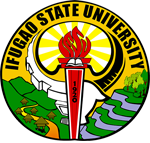




The Ifugao Rice Terraces is designated as a Globally Important Agricultural Heritage Systems (GIAHS) site for its outstanding contribution in the promotion of food security, biodiversity, indigenous knowledge and cultural diversity for sustainable development. This is the result of the Ifugaos tenacity in sustaining the terraces for over hundreds of years as the reflective definition of their culture in the midst of civilization evolution. It then defines their continuous quest in achieving food security and or sustainability. With this, it compels them to interminably hold the external demand of resources for its accessibility from tilling to table. It as well binds the potential to stabilize its communities as it promotes local values passed from generation to generation. This values covers agricultural and forestry systems, community development and food as the motive for living.
On September 25, 2020, the GIAHS Center of Ifugao State University held a documentation of Ifugao indigenous cuisines to be produced as an e-learning material. Since the educational system shifted to virtual learning due to the pandemic restrictions for face-to-face education, the transfer of indigenous knowledge must also be flexible and persistent. The said learning material will be made available online and shared to indigenous knowledge educators and learners.
Ifugao indigenous cuisine is characterized by the nature of its people for being festive defined by its culture and tradition. Almost all festivities and rituals are associated with the rice terraces agricultural system from land preparation to food consumption. These festivities often require protein-based (pork, poultry, fish and aquatic and dairy), rice-based (rice wine, rice and rice cake), fruits and vegetables.
The promotion and continuing cooking of these cuisines will aid in the conservation of the food resources because of its demand, hence their propagation and continuing production.
There are three (3) widely used method of cooking and preparation that include pure boiling (hibak/lambung), roasted (puluk/hanglag) and sun/air/smoke drying (tapa/hay-ung). Among the common cuisines are the following:
|
Main Dish / Savory |
||
|
Name of Cuisine |
Translation |
Ingredients Base |
|
1. Inlagim |
Boiled Chicken |
Chicken and Ginger |
|
2. Inlambung an Dotag |
Boiled Pork |
Pork |
|
3. In-utum |
Roasted/Steamed Fish |
Aquatic Fish (loach, million fish, river fish) |
|
4. Kiniing / Pinindang |
Ham/Bacon |
Pork |
|
5. Pinunnog |
Sausage |
Pork and herbs |
|
6. Latud/Hatud/Pihing |
Gabi |
Gabi and Ginger |
|
Snacks / Sweet |
||
|
1. Imbule / In-ugad |
Rice cake |
Rice and Sugar |
|
2. Inhibak with liningkot |
Boiled rootcrop |
Root Crop and Sugar Syrup |
|
Beverages / Drinks |
||
|
1. Bayah |
Rice wine |
Rice |
|
2. Kapeh |
Coffee |
Coffee |
|
4. Inhanglag |
Rice brew |
Rice |
|
6. Inlaplap |
Sweet potato stock |
Root crop (sweet potato) |
However, food resources in the Ifugao socio-ecological production landscape are being threatened by the loss of indigenous flora and fauna. The Ifugao Satoyama Meister Training Program documented the state of these Ifugao food resources.
|
Food Resources |
Eco Classification |
ISMTP References |
|
Aquatic resources ginga, battikul, kuwiwwiw, aggudung, tikkam, uggadiw, yuyu, tamtampi |
diminishing due to invasive predators, chemical input in the RT and its peripherals |
Tayaban, 2016 Tobiagon, 2018 Pumihic, 2017 |
|
Rootcrops sweet potato, taro, ube |
diminishing due to rodents, stem/root rot (Erwinia chrysanthemi) and other diseases |
Verano, 2017 Pumihic, 2017 Layaona, 2018 |
|
Heirloom Rice ingngudpur, imbu-uh, bongkitan, ngofor, pfu’an, bunkitan, ingup-ul, bukig, gulih-I, ingkongkong,tabali, madduli, botnol, imbuukan etc. |
threatened / replaced due to the introduction of HYVs, climate change, economic shift, pests among others |
Wachayna, 2015 Nitapa, 2016 Gahid, 2017 Hagada, 2018 Onnon, 2018 Addug, 2018 Biniahan, 2018 |
|
Forest Resources ato-ang-ang, adlai, hapar, bulinnayo, dogwe, binul, galiwgiwon, tuwol, pinit, balangbang, alig (rare) |
existing to abundant since they thrive in high elevation where there is lesser population. |
Fukasan, 2015 Elahe, 2016 Habiatan, 2017 Mamanglo, 2018 |
The introduction of invasive species and high yielding varieties are alarmingly replacing the heirloom or indigenous food resource varieties in the rice terraces. The advent of chemical use of fertilizers and agricultural inputs are altering the resiliency of these indigenous food resources from pests and diseases. It is also endangering the aquatic resources from rivers and paddies as these chemical inputs are being washed away at irrigations and rivers. Thus, there is a need to intervene in mitigating these external factors so as to sustain food abundance to be continually available in serving indigenous cuisines. The extinction of food resources results to the collapse of culture that includes cuisines and food related traditions.
The documentation and promotion of indigenous cuisines support the conservation of food resources, agricultural systems, and biodiversity in Ifugao. It will encourage the interest of cooking indigenous cuisines for the younger generation and stirs action in the restoration, development and revitalization of indigenous cuisines relative to rice terraces conservation vis-à-vis being a GIAHS and UNESCO Heritage Site. #Clyde B. Pumihic